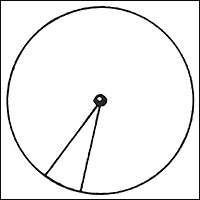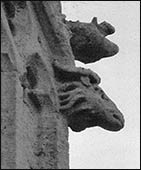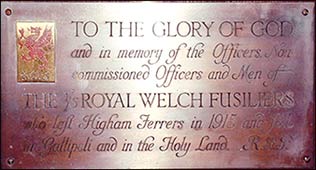| Archbishop Chichele founded this beautiful little chantry Chapel, with crocketed pinnacles, sometime after the Bedehouse.
The chapel became the Grammar School after the dissolution, and continued for over three centuries.
At the west end there is a statue of Archbishop Chichele.
|
|
|
|
Northampton County Magazine 1928
Higham Mass Dials
R. F. H. Clarke, Higham Ferrers, writes:
 |
|
Mass Dial
|
In the May number of the Northampton County Magazine you ask for a copy of the scratch dial on the old Grammar School. I send you a drawing of the same as near as possible, but the stone is weathering badly now. The hole in the centre is very badly worn, and was made in the horizontal joint between two stones, probably for ease. There do not appear to have ever been any more lines than I show. I enclose a small booklet, written by Canon H. K. Fry, who has studied Higham Church quite a lot, and who is, I believe, an authority on this subject.
Canon. Fry says in the little book issued by the S.P.C.K.:
The church, the bedehouse, and chantry each has its mass dial. These dials are to be carefully distinguished from Saxon dials, which differ not only in date but in design, and in the purpose for which they were made. Saxon dials, however small, never vary in design, and were intended to act as clocks that would tell the time at all the day hours.
The scratch dial is in reality a section of a formal sundial adapted to a special purpose, and hence it is not a time-teller, but a mass-marker. The scratch dial was probably first used after the Saxon sundial had gone out of vogue, and before the clock came into common use. In the majority of dials the mass line differs from all the rest, in some way or other, and it is often the only line. It is usually deeper and wider than the rest. Sometimes there is a hole on or at the end of this line, for a peg—sometimes the mass line (9 a.m.) is marked by a cross, or by being produced to a length beyond the others.
If the dials had a further use it was probably to denote the hour for vespers.
Rushden Mass Dial
|
 |
The Grammar School pupils in 1890s with Percy M Smith headmaster
|
| Percy Montague Smith was the headmaster at the Grammar School from 1890 until 1897. Born c1861 at Liverpool, he was married in 1894 in the Samford district of Suffolk, to Eleanor Ann Fosdick. She was known as Annie, and was born c1866 in the Ipswich district of Suffolk.
They moved to Peterborough, where a daughter, Ethel was born shortly before they came to Higham Ferrers in 1890. They left in 1897.
|
|
|
Grammar School, Higham Ferrers
(Founded 1422)
Boys prepared for Oxford and Cambridge Locals, College of preceptors, and other qualifications by experienced and successful tutor.
Vacancies for boarders. For terms, &c.
apply to the Head Master.
P. M. Smith
|
|
A Wellingborough News advert from December 1890
|
|
| Wellingborough & Kettering News 17/01/1890, transcribed by Peter Brown
Higham Ferrers - GRAMMAR SCHOOL—We hear that the Grammar School is to be re-opened at an early date by Mr. Smith, who has an establishment at Rushden.
|
18th January 1890 - Northampton Mercury
Higham Ferrers - Grammar School—We hear that this school is to be re-opened early date by Mr. Smith, who has an establishment at Rushden, and we further hear it has rather disconcerted the officers of the Young Men's Club, who, for more than fifty years, have held their meetings in the room free with the exception of the gas consumed, Mr. Smith having notified them that he does not consider that is enough.
|
Wellingborough & Kettering News 07/02/1890, transcribed by Peter Brown
GRAMMAR SCHOOL—The following paragraph appears in the current number of Truth:-Higham Ferrers Grammar School was founded in 1422 by Archbishop Chichele, who left £10 per annum in real estate to endow it. In the reign of Henry VIII., Robert Dacres was granted the estate on condition that he should maintain a schoolmaster and keep the school and Bede-house in repair. In 1734, the descendants of Robert Dacres sold the estate to the Earl of Malton, and it now is in the possession of Mr. W. C. W. Fitzwilliam. In 1839 the schoolmaster, Mr. Sanderson, had the use of a house in Higham Ferrers, and received a handsome salary from the estate. He was succeeded as schoolmaster by Mr. Clough, who had the use of a house. A new master has recently been appointed. He has no house; in vain he has called upon Mr. Fitzwilliam to renovate the school and outbuildings, and in vain he has asked for a salary. A handsome stained-glass window has been removed from the school and has been given to a church in the vicinity, while the lead roof has been taken away and replaced by a tiled one. It is evident that the estate on which the salary of the schoolmaster and the maintenance of the school are charged must be worth a good deal now, if it was worth £10 per annum in 1422. Action should therefore be taken to oblige Mr. Fitzwilliam to fulfil the obligations under which he holds it. The facts are interesting as showing how moneys left for the public benefit are absorbed by individuals.
|
In 1899 Alfred George Collins Vann became Head Master of Chichele Grammar School. He came from a working class background, studied hard and he frequently attended courses at Oxford University, gaining his MA degree in 1898 (see South End School Log Books), when he was the School Master at South End Elementary School in Rushden and his wife, Hannah Elizabeth Simpson Vann was a certificated teacher at the same school.
Their son Bernard William Vann was awarded the Victoria Cross in WWI.
|
|
The Grammar School, one of the oldest in the country, closed in 1906. The building was sold and presented to the Church in 1911 for £200.
|
|
 |
 |
|
The carved goat's head on one of the pinnacles
|
Plaque in the church to commemorate the men of the RWF who fell in WWI. Their mascot had been a goat. |
About 1920, the carved masonry of the old Grammar School was undergoing repairs, and one of the masons carved a goat’s head which now looks down from one of the pinnacles.
|
|
Rushden Echo & Argus, 26th February 1943, transcribed by Kay Collins
Ancient Higham Chapel Restored
Anonymous Benefactor Provides Funds
The “Church Times” of last week under “Diocesan News and Notes – Peterborough” has the following paragraph:-
A Virtue of Necessity—The ancient Jesus Chapel at Higham Ferrers, which until about 30 years ago, had been for centuries used as a Grammar School, is to be restored to its original use, and an altar will be consecrated by the Bishop Lang on Sunday Week, March 7th.
Wartime conditions of lighting and heating, which make the winter use of the magnificent Parish Church itself difficult on week-days, have expedited the rehabilitation of the chapel. Plans for its complete restoration, including the rood loft after the war were warmly approved by the Bishop’s Advisory Committee Funds for the purpose are being provided by an anonymous citizen of the borough.
When its use as a school came to an end early in this century, the chapel was bought by the late Dr Crew and presented to the benefice for the use of the Vicars of Higham.
|
|